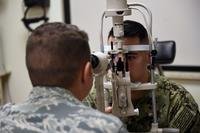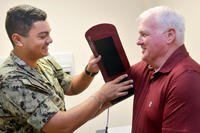by Tom Philpott
For older generations of spouses, mothers and other family caregivers of severely disabled veterans, the startling feature of the Family Caregiver Program that Congress enacted in 2010 was its exclusivity.
The unprecedented package of caregiver benefits includes training to help to ensure patient safety; cash stipends to partially compensate for caregiver time and effort; caregiver health coverage if they have none, and guaranteed periods of respite to protect against burn out.
The comprehensive package, however, isn’t available to most family members who are primary caregivers to severely ill and injured veterans.
To control costs, Congress opened the program only to caregivers of veterans severely “injured,” either physically or mentally, in the line of duty on or after Sept. 11, 2001. It is not open to families of severely disabled vets injured before 9/11. It also is not open to post-9/11 veterans who have severe service-connected illnesses, rather than injuries.
Advocates for these forgotten families had hoped a successful launch of a limited program would spur Congress to expand eligibility and end the obvious inequity it created. That hope is set back by a new Government Accountability Office report on the three-year-old Family Caregiver Program, which finds its under resourced and, for the most part, in disarray.
For starters, officials woefully underestimated the number of veterans eligible for the program, for which Congress set aside $1.5 billion to fund it through fiscal 2015. VA forecast 4000 approved caregivers by September this year. Instead, by last May, 15,600 had been approved out of an applicant pool of 30,400. Roughly 500 more are being approved monthly, GAO said, with no slowdown in sight.
Eight of every 10 approved caregivers are spouses of veterans. Ninety-two percent of them care for veterans with mental health diagnoses, mostly post-traumatic stress disorder (63 percent) or traumatic brain injury (26 percent). Stipends, based on local hourly caregiver wages, are set at three levels.
Caregivers providing a maximum of 40 hours of care per week receive an average of $2320 a month, or $27,830 annually. About 6000 caregivers qualify for this level.
An equal number provide a maximum of 25 hours’ care per week and draw an average $1470 a month. And 3,600 caregivers provide 10 hours of care weekly and receive on average $600 a month or $7200 a year.
Because VA “significantly underestimated caregivers’ demand for services,” GAO reports, VA medical centers were unprepared to meet program demands, particularly the work load on primary care physicians and nurses who must form into teams and visit homes of applicants to assess health needs and determine appropriate levels of caregiver support.
GAO also found that the computer system hastily adopted to track caregivers and work loads is inadequate and must be replaced if officials are to have data needed to monitor and resource the program effectively.
As the program now operates, a mandate to complete application reviews within 45 days is routinely missed. Also, some physicians and nurses have rebelled against the extra work, declining to visit homes to assess caregiver skills, veterans’ eligibility and proper level of support.
VA regional health officials told GAO, the report says, “that their facilities do not have sufficient medical staff to effectively manage the additional workload” from the program, “which they view as collateral duty.”
There are funds for medical centers to hire more Caregiver Support Coordinators who run the program locally by providing stipends and support services, and arranging CHAMPVA medical coverage for eligible caregivers. But GAO found some medical centers reluctant to hire enough CSCs for fear that funds available now to support caregivers will dry up in time, forcing medical centers to pinch spending on more critical priorities.
As a result, GAO reports, the ratio of coordinators to caregivers varies widely across the VA medical system. For example, there is one coordinator for six caregivers in Fayetteville, Ark., and also only one to support 251 caregivers at the Atlanta VA medical center in Decatur, Ga.
The workload on some CSCs is so heavy that caregivers can’t get their phone calls returned. One caregiver said she became desperate to learn how to manage a veteran with increasingly severe symptoms of traumatic brain injury. Her coordinator finally said her request was one of many and the program was too taxed to provide counseling. So the caregiver had to turn to an outside non-profit organization for help.
“There are just not enough people to run the program,” said Adrian Atizado, assistant legislative director for Disabled American Veterans, who has monitored the caregiver program since its start. “There are not enough support coordinators, not enough interdisciplinary providers and nurses to do the home visits. Also, keep in mind this program doesn’t exist anywhere else. This is the first of its kind so it’s going to have problems.”
All of the research and the studies that Congress relied to shape the program, Atizado added, had focused on caregiver needs for the elderly, not for a younger generation of veterans struggling to reengage with society.
Atizado noted that most caregivers of severely disabled veterans, including most represented by DAV, aren’t eligible for the comprehensive caregiver benefit, although they want to be and should be.
“We have always asked that eligibility include illness so if you come down with multiple sclerosis or ALS, a prevalent disease for the veteran population that served in Southwest Asia for whatever reason,” Atizado said, “that should be covered. Now, it is not allowed.”
Caregivers of older vets also should be covered, he said. Most caregivers of severely disabled Vietnam and Korean War veterans “are spending their estates to support their veterans at home. They haven’t worked in 20 to 30 years. They have no Social Security or retirement. These are the veterans and caregivers we’re fighting to get expansion for.”
Problems with the current program don’t help, he agreed.
VA concurred with GAO recommendations to fix the program so eligible caregivers get the services they need. How long it will take is not yet clear.
Send comments to Military Update, P.O. Box 231111, Centreville, VA, 20120, email milupdate@aol.com or twitter: @Military_Update



